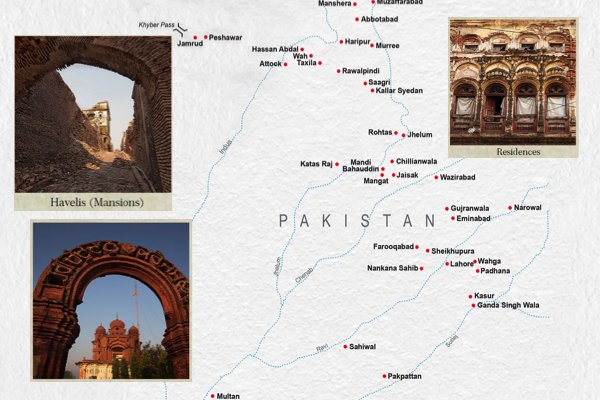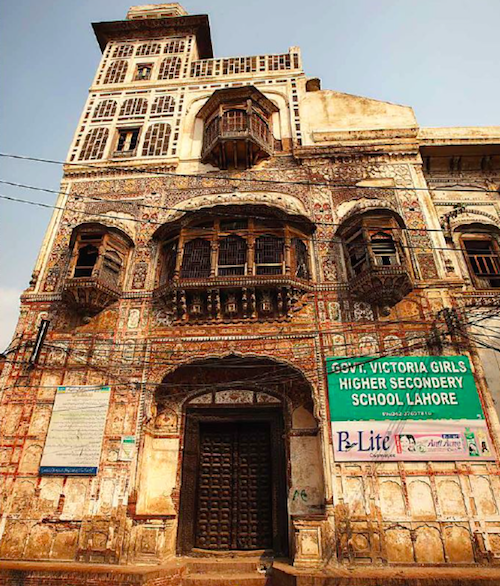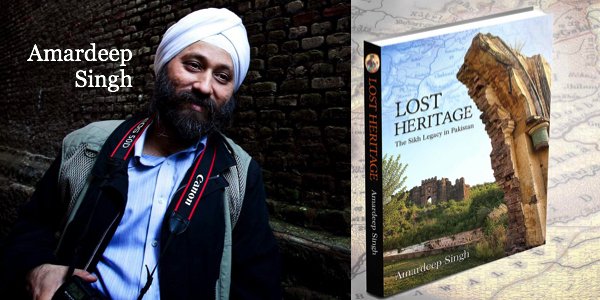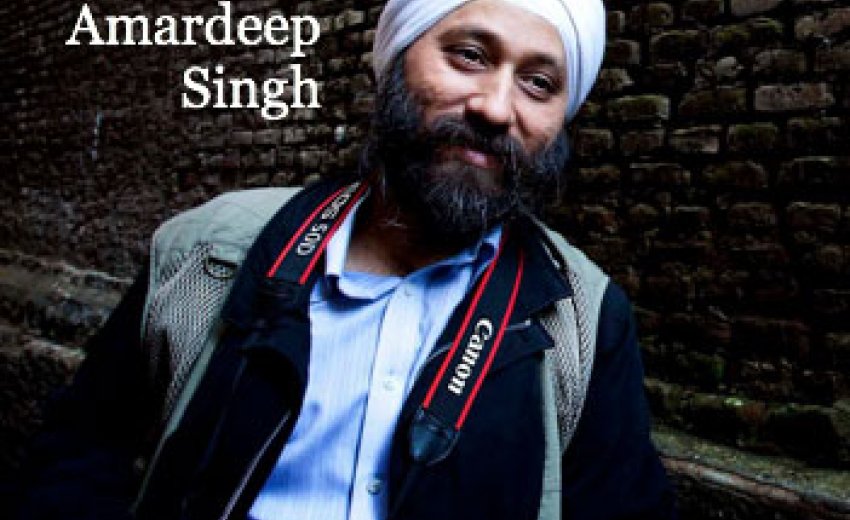September 21, 2015: A good part of the Sikh history lies in what is today the modern Pakistan. Kartapur is an example. Guru Nanak, the first Sikhs Guru, had spent some 18 years here. It lies only a few miles from the Dera Baba Nanak, the town now in the modern-day Punjab on the Indian side.
But not many have been able to visit the sites connected to the early days of the Sikh faith. Travel to Pakistan is still restricted, especially for those holding Indian passports.
A soon-to-be-launched book, Lost Heritage – The Sikh Legacy in Pakistan, aims to plug the gap.
Come December 2015, Amardeep Singh, a Singapore-based author and photographer, plans to roll out the book. It contains over 50,000 words, interspersed with 523 photographs, to present the diverse remnants of the community across the country.
“Seven decades after the searing partition of 1947, the Sikh community remains deprived of its glorious heritage, wrenched from it and now virtually inaccessible to most,” he tells Asia Samachar in an email interview.
“The biggest hurdle preceding the book project was with reference to travelling across Pakistan, armed with nothing more than a passion. The journey was preceded by apprehension from all quarters.”
When asked how did the idea come about to write the book, Amardeep said that he did not embark on writing a book. “Mine was just a travel to the remote areas of Pakistan to satisfy my curiosity.
But the journey to give life to the book had been full of challenges.
“The biggest hurdle emerged to be to get the book published and I hadn’t comprehended this would be such a challenge. Publishers viewed this as commercially unviable and hence no one was forthcoming to undertake it,” he said.
Read full interview below.

Asia Samachar: What prompted you to work on this book?
Amardeep Singh: I am a born wanderer. Wanderers don’t need a point of deflection to find new inspirations. It is my innate nature to always look at my surrounding with an explorers vision, which has enabled me to pursue divergent activities in my life. I see myself as a white cloud floating freely in the sky, unknowingly abandoning myself in search for the unknown, which eventually has always lead me to an aim that has always been present but hidden deep inside me. Journey of life has to be experienced through effort. One can never know what lies ahead, but a step in the right direction, with the right effort will ultimately result in a bloom.
I see our generation as the last link between the ones directly impacted by the partition of India in 1947 and the present who have little emotional attachment to that cataclysm. We have grown up hearing firsthand accounts from those who were affected and uprooted, struggling thereafter as refugees in other parts of India and the world in their endeavour to re-start their lives.
Seven decades after the searing partition of 1947, the Sikh community remains deprived of its glorious heritage, wrenched from it and now virtually inaccessible to most. For those fortunate few able to visit Pakistan, their pilgrimages are confined to the few functional gurdwaras at Lahore, Nankana Sahib, Hassan Abdal, Kartarpur Sahib and Eminabad.
Would the heritage of the land where Sikhism was born and the Sikhs had created an empire have been limited to just these few functional gurdwaras? What about magnificence of the hundreds of gurdwaras that once adorned every village of this land? And then, the scores of impregnable forts and historic battlegrounds that are intrinsic in Sikh history and which existed across the Punjab, North West Frontier and Kashmir? Are there any remains of art and architecture of the Sikh era that could provide insight of the erstwhile society?
This is what prompted me to satisfy my quest. I did not embark on writing a book. Mine was just a travel to the remote areas of Pakistan to satisfy my curiosity. However on return to Singapore, as I revisited the 19th century travelogues of the Europeans who had then travelled across the Sikh empire, which primarily existed across Pakistan, I wondered, whether I too should document my experiences! Could my work, interspersed with visuals serve as a window for future generations to comprehend some aspects of the Sikh heritage that the community is unable to freely access after the partition of 1947?
When did you start, and when did it end?
It is hard to say when one started and surely it has not ended. A project of this magnitude can only be accomplished by a life-long passionate building blocks that unknowingly transition into advancing levels. To travel into Pakistan in search of Sikh legacy that is beyond the few functional gurdwaras, one has to be firstly well versed about where the footprints had existed. This means, one should have been reading about one’s history and heritage for years. Then over the years one needs to have honed up the literary and photography skills as in this book, I am the researcher, author and the photographer. Surely these skills can’t be acquired overnight.
Each building block has helped me move towards my goal to visit Pakistan, not to be just like one of the many Sikh pilgrims but to go beyond and explore the vestiges of the legacy. For years, I had continued to fan the desire and finally life created a window in October 2014, by when I had left my 24 years of corporate role in the financial industry. It is then that I travelled for 30 days across West Punjab, Khyber Pakhtunkhwa and Pakistan Administered Kashmir in search of the Sikh legacy.
The book though may seem to have completed as it is scheduled for December 2015 release but for me this is the platform through which I wish to undertake deeper research. It is my desire to first get the “LOST HERITAGE – The Sikh Legacy in Pakistan” in as many homes across the world and simultaneously kick start the second wave of research. There is a lot of our remnants, yet to be documented across Pakistan.
What was the most challenging part of preparing this book?
A 500 page book, with over 50,000 words, interspersed with 523 photographs and 14 maps, is a humongous task to be completed in one years’ time. While this specific aspect was challenging enough but it was under my direct control, so manageable.
The biggest hurdle emerged to be to get the book published and I hadn’t comprehended this would be such a challenge. Costs for a thick 12.25 inch by 9.25 inch book in art paper pitches the work into a premium positioning segment. Most Art paper coffee table/illustrated books are between 200-300 pages, which meant I was trying to pack two books into one. Publishers viewed this as commercially unviable and hence no one was forthcoming to undertake it.
For me, the project was a life time’s labour of love, which I was unwilling to compromise. At times it felt that the project would not see the light at the end of the tunnel but I maintained my focus, strongly believing that if there is value in this work then it will find its way.
I therefore embarked on a building block based publishing model, crowd sourcing the finances to break-even the costs, at which point the project became viable. It’s at this stage that I picked and chose the partners that I now desired to work with.
I thank Nagaara Trust and Himalayan books who have come together to jointly publish this book.
What were the other challenges faced to produce the book?
The biggest hurdle preceding the book project was with reference to travelling across Pakistan, armed with nothing more than a passion. The journey was preceded by apprehension from all quarters. Friends could not fathom what had begot me. I thank my family for having allowed me to fulfill the calling. Without their emotional support and confidence, this endeavour would not have been possible.
There has been an invisible hand working enabling every aspect of this project. As I entered the country with just a desire and faith, I kept getting connected with like-minded people, and all came together to help.
 |
| Exterior of haveli of Naunihal Singh (1821-1840) which witnessed the conspiracies hatched to detrone Kharak Singh, who had ascended the throne after Maharaja Ranjit Singh. – Material from Page 64 |
What is the one key lesson you picked up while preparing this book?
My philosophy in anything I undertake is to “move without a Mind”.
One needs to have a vision, fuel the passion and once the furnace is prepared, one needs to move with no preconceived notions. It’s this aspect of “moving without the Mind”, that allows one to see beyond seeing and smelters the ore in the furnace, resulting in a valuable product.
Letting things happen, while focussing on right effort, is the key lesson!
The book contains 523 photos. Your personal favourite photo in the book? Why?
This book is about the pain that the community went through. I find it hard to pick a favourite photo amongst the vestiges of the legacy that is soon to vanish in totality.
I will let the reader create their own favourite by letting their imagination go back in time, using the pictures as a catalyst to join the dots, imagining the glory of the Sikh society in these lands as it once was.
Tell us more about the book?
The uniqueness of this work lies in its diversity of exploration. It provides insight to the glorious era by exploring the relinquished heritage, spanning between 15th and 21st century. The narrative covers not one but many aspects of the Sikh legacy, covering historic monuments, forts, battlegrounds, commercial and residential establishments and places of worship. This illustrative exploration of arts, architecture, culture and history, discerns the erstwhile secularity of the region. Across all communities, ‘Lost Heritage: The Sikh Legacy in Pakistan’ is aimed at providing a strong impetus to those in search of their roots and for those interested in the bygone era.
MORE ABOUT THE BOOK, GO HERE.
TO PLACE A PRE-ORDER AT A DISCOUNTED PRICE, GO HERE.
[ASIA SAMACHAR is an online newspaper for Sikhs in Southeast Asia and surrounding countries. We have a Facebook page, do give it a LIKE! Follow us on Twitter. Visit our website: www.asiasamachar.com]
---------------------------------
Related Article:
http://www.sikhnet.com/news/lost-heritage-book-review-amardeep-singh
